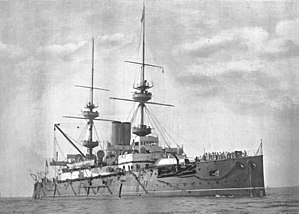HMS Prince George (1895)

HMS Prince George
|
|
| History | |
|---|---|
|
|
|
| Name: | HMS Prince George |
| Namesake: | Prince George, the future King George V |
| Builder: | Portsmouth Dockyard |
| Laid down: | 10 September 1894 |
| Launched: | 22 August 1895 |
| Christened: | Duchess of York |
| Commissioned: | 26 November 1896 |
| Decommissioned: | 21 February 1920 |
| Renamed: | HMS Victorious II in July or September 1918; name reverted to Prince George in February 1919 |
| Fate: | Sold for scrapping 22 September 1921 |
| General characteristics | |
| Class and type: | Majestic-class pre-dreadnought battleship |
| Displacement: | 16,060 t (15,810 long tons; 17,700 short tons) |
| Length: | 421 ft (128 m) |
| Beam: | 75 ft (23 m) |
| Draught: | 27 ft (8.2 m) |
| Propulsion: | 2 × 3-cylinder triple expansion steam engines, twin screws |
| Speed: | 16 knots (30 km/h; 18 mph) |
| Complement: | 672 |
| Armament: |
|
| Armour: |
|
HMS Prince George was a Majestic-class pre-dreadnought battleship launched in 1895. She was named after the future George V of the United Kingdom and was the fourth and final ship to bear that name. Commissioned in 1896, she initially served with the Channel Fleet until 1904. She was involved in a collision with her sister ship, Hannibal, and the resulting damage meant that much of the latter part of 1903 was spent being repaired. After a refit in 1904, she was assigned to the Atlantic Fleet and then from 1907, she was part of the Home Fleet. In 1912, she was assigned to the 7th Battle Squadron.
When World War I broke out Prince George, together with the rest of the squadron, was attached to the Channel Fleet during the early stages of the war. In early 1915, she was dispatched to the Mediterranean for service in the Dardanelles Campaign. She participated in bombardments of Turkish forts and supported the Allied operations at Gallipoli, including the evacuation from the peninsula late in 1915. She spent the remainder of the war back in the United Kingdom, initially as an accommodation ship before being converted to a depot ship for destroyers in 1918 and stationed at Scapa Flow. For this latter role, she was renamed Victorious II before reverting to her original name in 1919. Decommissioned in 1920, she was sold for scrapping to a German company but sank off the Netherlands during transit to Germany.
Prince George was laid down at the Portsmouth Dockyard on 10 September 1894. She was launched less than a year later, on 22 August 1895, after which fitting-out work commenced. The ceremony was performed by HRH the Duchess of York (later Queen Mary), in the presence of her husband Prince George, Duke of York (later King George V), for whom the ship was named. She was commissioned into the Royal Navy on 26 November 1896. The ship was 421 feet (128 m) long overall and had a beam of 75 ft (23 m) and a draft of 27 ft (8.2 m). She displaced up to 16,060 t (15,810 long tons; 17,700 short tons) at full combat load. Her propulsion system consisted of two 3-cylinder triple expansion engines powered by eight coal-fired cylindrical boilers. By 1907–1908, she was re-boilered with oil-fired models. Her engines provided a top speed of 16 knots (30 km/h; 18 mph) at 10,000 indicated horsepower (7,500 kW). The Majestics were considered good seaboats with an easy roll and good steamers, although they suffered from high fuel consumption. She had a crew of 672 officers and enlisted men.
...
Wikipedia
